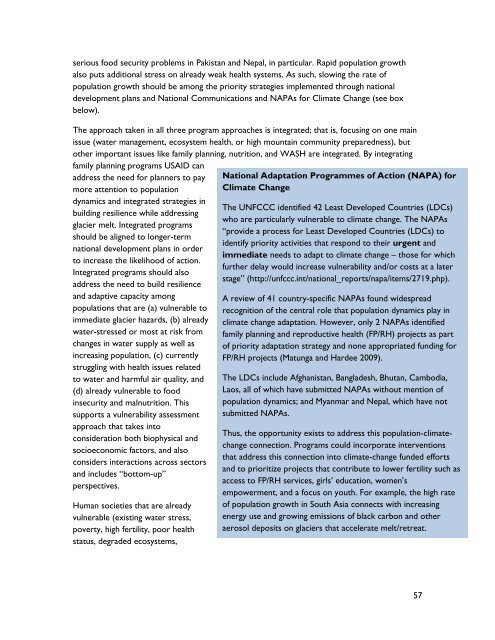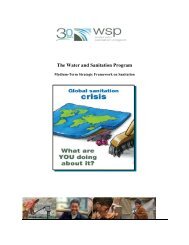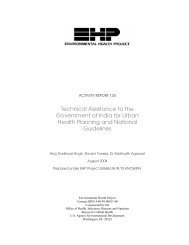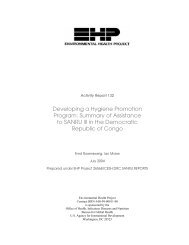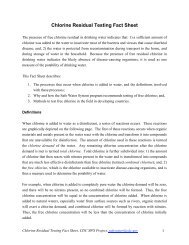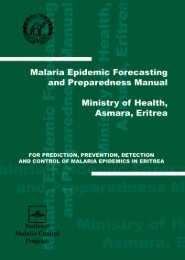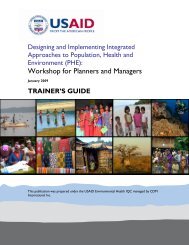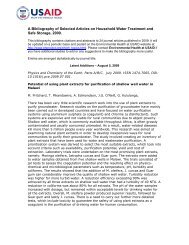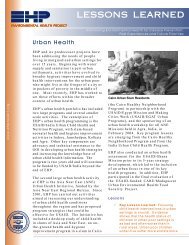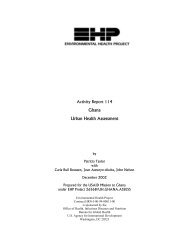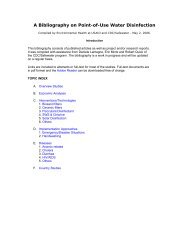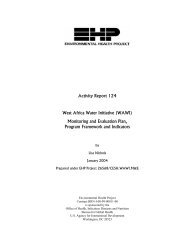Changing Glaciers and Hydrology in Asia - Environmental Health at ...
Changing Glaciers and Hydrology in Asia - Environmental Health at ...
Changing Glaciers and Hydrology in Asia - Environmental Health at ...
- No tags were found...
Create successful ePaper yourself
Turn your PDF publications into a flip-book with our unique Google optimized e-Paper software.
serious food security problems <strong>in</strong> Pakistan <strong>and</strong> Nepal, <strong>in</strong> particular. Rapid popul<strong>at</strong>ion growthalso puts additional stress on already weak health systems. As such, slow<strong>in</strong>g the r<strong>at</strong>e ofpopul<strong>at</strong>ion growth should be among the priority str<strong>at</strong>egies implemented through n<strong>at</strong>ionaldevelopment plans <strong>and</strong> N<strong>at</strong>ional Communic<strong>at</strong>ions <strong>and</strong> NAPAs for Clim<strong>at</strong>e Change (see boxbelow).The approach taken <strong>in</strong> all three program approaches is <strong>in</strong>tegr<strong>at</strong>ed; th<strong>at</strong> is, focus<strong>in</strong>g on one ma<strong>in</strong>issue (w<strong>at</strong>er management, ecosystem health, or high mounta<strong>in</strong> community preparedness), butother important issues like family plann<strong>in</strong>g, nutrition, <strong>and</strong> WASH are <strong>in</strong>tegr<strong>at</strong>ed. By <strong>in</strong>tegr<strong>at</strong><strong>in</strong>gfamily plann<strong>in</strong>g programs USAID canaddress the need for planners to paymore <strong>at</strong>tention to popul<strong>at</strong>iondynamics <strong>and</strong> <strong>in</strong>tegr<strong>at</strong>ed str<strong>at</strong>egies <strong>in</strong>build<strong>in</strong>g resilience while address<strong>in</strong>gglacier melt. Integr<strong>at</strong>ed programsshould be aligned to longer-termn<strong>at</strong>ional development plans <strong>in</strong> orderto <strong>in</strong>crease the likelihood of action.Integr<strong>at</strong>ed programs should alsoaddress the need to build resilience<strong>and</strong> adaptive capacity amongpopul<strong>at</strong>ions th<strong>at</strong> are (a) vulnerable toimmedi<strong>at</strong>e glacier hazards, (b) alreadyw<strong>at</strong>er-stressed or most <strong>at</strong> risk fromchanges <strong>in</strong> w<strong>at</strong>er supply as well as<strong>in</strong>creas<strong>in</strong>g popul<strong>at</strong>ion, (c) currentlystruggl<strong>in</strong>g with health issues rel<strong>at</strong>edto w<strong>at</strong>er <strong>and</strong> harmful air quality, <strong>and</strong>(d) already vulnerable to food<strong>in</strong>security <strong>and</strong> malnutrition. Thissupports a vulnerability assessmentapproach th<strong>at</strong> takes <strong>in</strong>toconsider<strong>at</strong>ion both biophysical <strong>and</strong>socioeconomic factors, <strong>and</strong> alsoconsiders <strong>in</strong>teractions across sectors<strong>and</strong> <strong>in</strong>cludes “bottom-up”perspectives.Human societies th<strong>at</strong> are alreadyvulnerable (exist<strong>in</strong>g w<strong>at</strong>er stress,poverty, high fertility, poor healthst<strong>at</strong>us, degraded ecosystems,N<strong>at</strong>ional Adapt<strong>at</strong>ion Programmes of Action (NAPA) forClim<strong>at</strong>e ChangeThe UNFCCC identified 42 Least Developed Countries (LDCs)who are particularly vulnerable to clim<strong>at</strong>e change. The NAPAs“provide a process for Least Developed Countries (LDCs) toidentify priority activities th<strong>at</strong> respond to their urgent <strong>and</strong>immedi<strong>at</strong>e needs to adapt to clim<strong>at</strong>e change – those for whichfurther delay would <strong>in</strong>crease vulnerability <strong>and</strong>/or costs <strong>at</strong> a l<strong>at</strong>erstage” (http://unfccc.<strong>in</strong>t/n<strong>at</strong>ional_reports/napa/items/2719.php).A review of 41 country-specific NAPAs found widespreadrecognition of the central role th<strong>at</strong> popul<strong>at</strong>ion dynamics play <strong>in</strong>clim<strong>at</strong>e change adapt<strong>at</strong>ion. However, only 2 NAPAs identifiedfamily plann<strong>in</strong>g <strong>and</strong> reproductive health (FP/RH) projects as partof priority adapt<strong>at</strong>ion str<strong>at</strong>egy <strong>and</strong> none appropri<strong>at</strong>ed fund<strong>in</strong>g forFP/RH projects (M<strong>at</strong>unga <strong>and</strong> Hardee 2009).The LDCs <strong>in</strong>clude Afghanistan, Bangladesh, Bhutan, Cambodia,Laos, all of which have submitted NAPAs without mention ofpopul<strong>at</strong>ion dynamics; <strong>and</strong> Myanmar <strong>and</strong> Nepal, which have notsubmitted NAPAs.Thus, the opportunity exists to address this popul<strong>at</strong>ion-clim<strong>at</strong>echangeconnection. Programs could <strong>in</strong>corpor<strong>at</strong>e <strong>in</strong>terventionsth<strong>at</strong> address this connection <strong>in</strong>to clim<strong>at</strong>e-change funded efforts<strong>and</strong> to prioritize projects th<strong>at</strong> contribute to lower fertility such asaccess to FP/RH services, girls’ educ<strong>at</strong>ion, women’sempowerment, <strong>and</strong> a focus on youth. For example, the high r<strong>at</strong>eof popul<strong>at</strong>ion growth <strong>in</strong> South <strong>Asia</strong> connects with <strong>in</strong>creas<strong>in</strong>genergy use <strong>and</strong> grow<strong>in</strong>g emissions of black carbon <strong>and</strong> otheraerosol deposits on glaciers th<strong>at</strong> acceler<strong>at</strong>e melt/retre<strong>at</strong>.57


